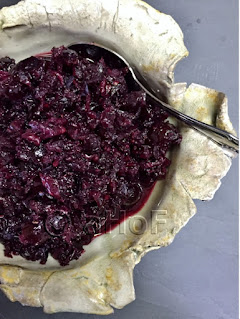I started out the day wondering what to do with the pork shoulder roast I had bought, and cast around for inspiration. I went to see what herbs are still alive in my sun room and came back with handfuls of oregano and parsley. Okay, while oregano is not my normal go-to herb for pork, it was still so full and lush that I went for it. Thinking of a somewhat sweet and sour effect, I used some currant jelly that was taking space in the fridge, along with lime juice. And then came the real inspiration: roasted garlic. Granted, this is a step that must be accomplished well in advance, but should you make some roasted garlic for any other reason and have some leftover (as I did), then this is a truly inspired use for it.
Making Roasted Garlic
 |
| Roasted Garlic |
With a very sharp knife, cut across the top of a whole head of garlic, removing about ¼ inch and exposing most of the garlic cloves (some outermost cloves will remain below the cut line but this is of no importance). Set the head of garlic onto the center of the foil, cut side up. Drizzle the top with about a tablespoon of olive oil. At this point, I also had fresh thyme handy, and stripped a stem of thyme leaves and strewed them over the garlic, but this is entirely optional. Bring the foil up and around the garlic to make a little packet and set the packet(s) onto a baking sheet, or in a casserole, or in the wells of a muffin tin. Bake the garlic for 40 to 60 minutes. The timing will depend on how large the heads of garlic are and how caramelized you want the final product. You will know by the delicious aroma when they are nearing perfection.
Once the garlic is finished roasting, allow the packets to cool, then you may either use immediately or refrigerate. They may be refrigerated as is, or you can remove the individual cloves from their skins very easily. They just slide out whole. For those few cloves that did not have an end cut off, just tear through the skin at one end and squeeze. Store the cloves, along with any olive oil from roasting. Once all the cloves are in a jar, top off to cover with more olive oil and seal tightly. This way they will keep for a very long while.
 |
| Pork Shoulder Roast Low and Slow |
Using this Inspiring Garlic
At this point, with roasted garlic in the fridge, this is where I was when that inspiration hit. My jar of garlic in olive oil had gotten hidden in the back of the fridge and I had forgotten about it. But really - pork and garlic are a match made in heaven any day, so I got out my jar, which held about a whole head worth of garlic cloves. I scraped the entire jar worth into the slow cooker! And the flavors when the roast was done were so out-of-this-world I could hardly believe my taste buds. This recipe is a true must-try for anyone who loves pork!The garlic, having been roasted previously, starts out already sweet in this recipe, so the flavor of garlic as one would think might be overwhelming, just made a most delightful underlying flavor structure, without being able to precisely identify what that flavor was. I made gravy with the pot liquid and oh heavens! I did mash up the garlic in the mixture, but otherwise left all the liquid as is, with all its bits and pieces. My husband has been truly chowing on this roast! As I was doing the same myself, I completely forgot to take photos, until I was nearly done with my meal!
My next use for roasted garlic will have to be a dip. There are so many luscious recipes out there just waiting.
Pork Shoulder Roast, Low and Slow
 |
| Pork Shoulder Roast Low and Slow |
1 (4 - 5 pound) boneless pork shoulder roast
1 whole head roasted garlic cloves (see above)
½ cup fresh Italian parsley, chopped
¼ cup red currant jelly
2 tablespoons minced fresh oregano leaves
2 tablespoons lime juice
1½ teaspoons salt
½ teaspoon freshly ground pepper
Set the pork roast into the slow cooker and add remaining ingredients. Cover and set on High (my slow cooker has "Low" or "High" as settings - you may need to alter this for your slow cooker) for 6 hours. Tear the roast apart and serve.
I served this roast with sweet potatoes and apple and a side of broccoli. On the second night I made mashed potatoes to go with leftovers.
My passion is teaching people how to create a harmony of flavors with their cooking, and passing along my love and joy of food, both simple or exotic, plain or fancy. I continue my journey in ethnic and domestic cuisines, continuing my journey to explore diverse culinary experiences and hopefully to start you on a journey of your own. Join me also at A Harmony of Flavors on Facebook, and Pinterest.


































